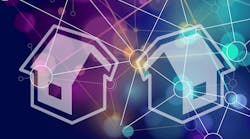This file type includes high resolution graphics and schematics when applicable.
There are a lot of myths swirling around the home-automation market. In the smart-home arena, connected systems are losing out to point solutions. I talked with Cyril Brignone, Chief Executive Officer of Arrayent, to find out why.
Wong: Cyril, you have been involved in the Internet of Things market since 2000 at HP Labs. What's changed over the last 15 years?
Brignone: Two changes stand out—the smartphone/tablet and cloud computing. Smartphones appeared and became ubiquitous to the point where nearly half the world's population owns one. The smartphone is important in a number of ways. First, it has become the volume driver to lower silicon costs. Today you can purchase a Wi-Fi module for less than $5. That makes it practical to add Wi-Fi into everything you make. Many consumer brands are committed to putting Wi-Fi into everything. Second, it's a screen that most people carry with them everywhere, so it is essentially a common interface to almost everything. It means that for a majority of products, you no longer have to deal with a crude screen, or non-intuit button/switch interface.
Cloud computing is important in that it enables product designers to remove complexity locally and push that complex to the cloud, where computation and memory resources are much more scalable. The cloud is where mobile voice-recognition processing is done for Apple Siri, Google, and Amazon's Alexa. It is also emerging to be the place where companies can create interoperable systems much more rapidly than was possible before.
Wong: And what has stayed the same?
Brignone: The market penetration of traditional central monitored home security, with a $20 to $50 per month subscription, has stayed roughly 20% adopted over this period. And the adoption of DIY home-security systems, with a subscription of $10 a month, remains very small.
Wong: Why aren't adoption rates increasing?
Brignone: It's simple economics: high cost means low adoption. The home-security market is based on a hardware cost subsidized by a subscription contract model. Security hardware is expensive and it takes skilled labor to install and set up. The upfront cost is too high for any adoption, so the cost is spread across a two- or three-year contract. It's a business model the wireless carriers borrowed to make $650 smartphones affordable.
In the case of DIY security, there is no free lunch. By that I mean that the DIY over-the-top broadband hardware cost might be a little lower than 3G/4G hardware for a monitored security system, but the DIY system still has to be installed. A dirty secret in the consumer IoT space is that things are hard to connect to home networks and hubs. So while there may not be the dollar cost, there is time cost that most consumers today won't tolerate.
Wong: So what's the solution?
Brignone: First you have to realize that no one wakes up on Saturday morning and says to themselves: "I have a home-automation problem." Second, recognize what retailers have known for years—consumers go online or drive to a store on a mission, which is to find a point solution to fix their pain. Whether that is to replace a broken or worn-out thing, or buy that cool item that their friend owns. So it is critical to the brand owner to focus on compelling use cases, delivered as point solutions. Essentially, we are seeing a process of one retrofit upgrade at a time. So the smarthome will happen, one point solution at a time.
At the same time, it is interesting to note that the home construction industry is looking at making all of their new homes into smarthomes. Just like OSRAM, Whirlpool, and Chamberlain, which are adding connectivity to their products, home-construction companies like KB Homes are building sensing and connectivity capability into their homes. Why? Early market research shows that the new generation of millennial homebuyers is going to expect that homes just come smart.
Wong: So what's a consumer-product company to do?
Brignone: For now, be really good at one task/solution to start. Product reviews with 4+ stars matter more than brands these days. It is only then that you can add more features to your first product. Later add a second and third product that customers will consider buying. Over time, consumers will acquire a number of connected point solutions that are solving problems for them a few times a week. This will take time, of course.
And then they will move to stage two, wanting their things to work together. This is the Google Nest strategy. Thermostat first. Smoke detector second (the Trojan horse is adding more sensors to the home), and then the DropCam camera. They have added the Connect to Nest program to grow their ecosystem that already includes products from Whirlpool, Chamberlain, Mercedes, OSRAM, and Philips. These companies can take advantage of Nest's Home and Away API capabilities for their own products. They are laying the groundwork for connected systems that work the way individuals work.
Wong: What is actionable advice to traditional product manufacturers?
Brignone: The most important thing in a connected-product initiative is to gain a cloud presence. Once you have that, business expansion opportunities open up. People want the product they buy to be compatible with an IoT ecosystem like Nest, Alarm.com, and others. This opens great new sales channels for the product manufacturer.
Wong: But not everyone is a Google or Apple with abundant resources to build out a cloud presence. So how can a traditional product company go about getting a cloud presence?
Brignone: We see three approaches: build an IoT cloud yourself; hire an IT services company like IBM to write one for you; or buy a commercial IoT platform. In the history of enterprise software, commercial product offerings always end up being cheaper, more fully featured, and more reliable than any one-off software project can be. No one today would imagine writing an accounting, CRM, or ERP system from scratch. This will be the same for IoT platforms, too.


